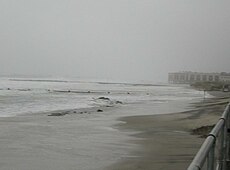Portal:Tropical cyclones/Featured article/Effects of Hurricane Isabel in New Jersey

The effects of Hurricane Isabel in New Jersey were overall moderate, limited to fallen trees, two deaths, and $50 million in damage (2003 USD, $55 million 2006 USD). Hurricane Isabel formed from a tropical wave on September 6 in the tropical Atlantic Ocean. It moved northwestward, and within an environment of light wind shear and warm waters it steadily strengthened to reach peak winds of 165 mph (265 km/h) on September 11. After fluctuating in intensity for four days, Isabel gradually weakened and made landfall on the Outer Banks of North Carolina with winds of 105 mph (165 km/h) on September 18. It quickly weakened over land and became extratropical over western Pennsylvania the next day. Several days before Isabel made landfall, there existed uncertainty in where the hurricane would strike. At least one computer model predicted a landfall on New Jersey, and as a result services across the state thoroughly prepared for the hurricane.
Isabel passed 215 miles (350 km) southwest of the state, though its large wind core produced tropical storm force winds across much of the state. The winds downed hundreds of trees and power lines, leaving hundreds of thousands without power. A falling tree killed one person. Hurricane Isabel produced rough waves and a moderate storm surge along the coastline. One person was killed from the rough waves, and at least 50 locations along the Jersey shore reported beach erosion from the hurricane.
Recently featured: Cyclone Gonu — List of Florida hurricanes (1975-1999) — Great Hurricane of 1780 — 1970 Bhola cyclone — Hurricane Fico — Hurricane Bob (1985) — Typhoon Ewiniar (2006) — Browse
